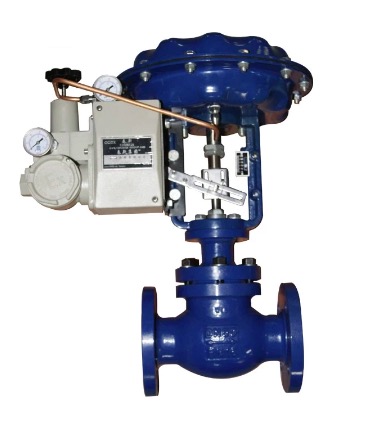
Control Valve
In the field of industrial automation process control, the regulating valve is the final control element that changes the process parameters such as medium flow, pressure, temperature, liquid level, etc. by means of power operation by accepting the control signal output by the regulating control unit. Generally composed of actuators and valves. According to the stroke characteristics, the regulating valve can be divided into straight stroke and angular stroke; according to the power used by the actuator, it can be divided into three types: pneumatic regulating valve, electric regulating valve and hydraulic regulating valve; according to their functions and characteristics There are three types of linear characteristics, equal percentage characteristics and parabolic characteristics. The regulating valve is suitable for air, water, steam, various corrosive media, mud, oil and other media. English name: control valve, the tag number usually starts with FV. Common classification of control valves: pneumatic control valve, electric control valve, hydraulic control valve, self-operated control valve.
Body Type
There are many types of valve bodies for regulating valves. Commonly used valve body types include straight-through single-seat, straight-through double-seat, angle, diaphragm, small flow, tee, eccentric rotation, butterfly, sleeve, ball, etc.
When making specific choices, consider the following:
(1) Spool shape structure
Mainly according to the selected flow characteristics and unbalanced forces and other factors.
(2) Wear resistance
When the fluid medium is a suspension containing a high concentration of abrasive particles, the internal material of the valve should be hard.
(3) Corrosion resistance
Since the medium is corrosive, try to choose a valve with a simple structure.
(4) The temperature and pressure of the medium
When the temperature and pressure of the medium are high and the change is large, the valve core and valve seat material should be selected with small changes in temperature and pressure. When the temperature is ≥ 250 ℃, a radiator should be added.
(5) Prevent flash evaporation and cavitation
Flash evaporation and cavitation only occur in liquid media. In the actual production process, flashing and cavitation will form vibration and noise, which will shorten the service life of the valve. Therefore, the valve should be prevented from flashing and cavitation when selecting the valve.
(6) Control valve actuator
In order to make the regulating valve work normally, the matching actuator must be able to generate enough output force to ensure a high degree of sealing and the opening of the valve.
For double-acting pneumatic, hydraulic, and electric actuators, there is generally no return spring. The magnitude of the force has nothing to do with its running direction. Therefore, the key to choosing an actuator is to find out the maximum output force and the torque of the motor. For single-acting pneumatic actuators, the output force is related to the opening of the valve, and the force on the control valve will also affect the motion characteristics, so it is required to establish a force balance over the entire opening range of the control valve.
After determining the output force of the actuator, select the corresponding actuator according to the requirements of the process use environment. When there are explosion-proof requirements on site, pneumatic actuators should be selected. From the perspective of energy saving, electric actuators should be selected as far as possible. If the adjustment accuracy is high, the hydraulic actuator can be selected. Such as speed regulation of transparent machines in power plants, temperature regulation and control of catalytic reactors in oil refineries, etc.
The mode of action of the regulating valve is only available when the pneumatic actuator is selected, and its mode of action is formed by the combination of the positive and negative action of the actuator and the positive and negative action of the valve. There are 4 kinds of combination forms, namely positive and negative (air-close type), positive and negative (air-open type), reverse (air-open type), and reverse-reverse (air-close type). Both on and off.
For the selection of the action mode of the control valve, three aspects are mainly considered: a. Process production safety; b. The characteristics of the medium; c. To ensure product quality and minimize economic losses.
Names of different types of control valves
Electric control valve, pressure control valve, single seat control valve, pneumatic control valve, sleeve control valve, double seat control valve, three-way control valve, temperature control valve, air volume control valve, self-operated control valve, fire control valve, diversion Control valve, manual control valve, cage control valve, micro-pressure control valve, fine and small control valve, angle control valve, rotary control valve, multi-leaf control valve, differential pressure control valve, straight-through control valve, electronic control valve, Confluence control valve, sealed control valve, steam control valve, water supply control valve, temperature control control valve, explosion-proof control valve, automatic control valve, stainless steel control valve, plastic-lined control valve, locking control valve, constant flow control valve, flap type Control valve, brass control valve, lift control valve, one-way control valve, bellows control valve, boiler feed water control valve, field bus control valve, etc.
